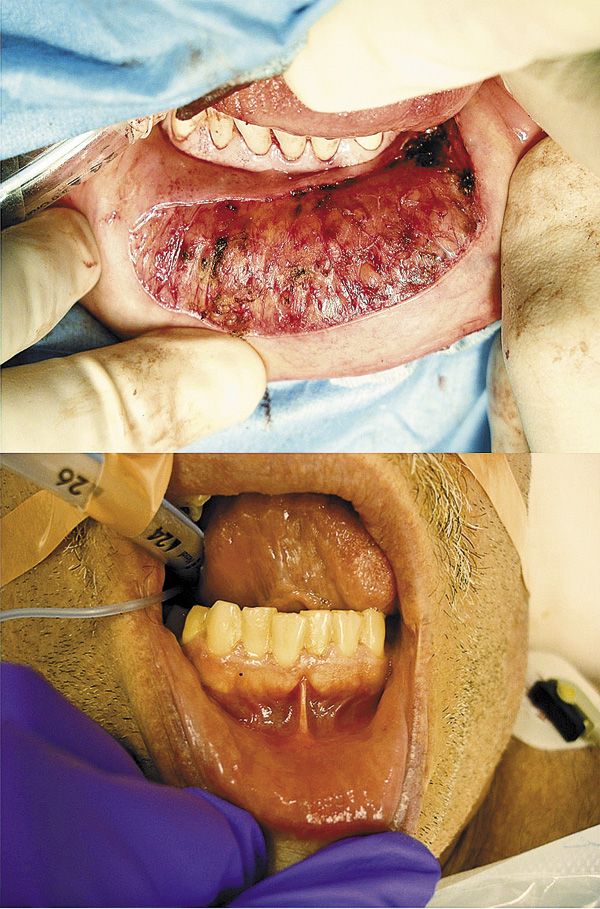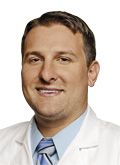Article
Labial, lingual mucosa grafts viable for urethroplasty
Labial and lingual mucosa are useful alternatives to buccal mucosa for graft urethroplasty, according to a recent study.
Tampa, FL-Labial and lingual mucosa are useful alternatives to buccal mucosa for graft urethroplasty, according to a recent study.
In the retrospective study, Paul Bradley, MD, and senior author Raul Ordorica, MD, reported their experience using labial and lingual mucosa grafts in 59 patients (48 and 12, respectively), including three women. The series comprised 36 single-stage dorsal onlay procedures and 26 staged repairs for distal urethral plate replacement in patients with balanitis xerotica obliterans, hypospadias, or epispadias. All patients were evaluated initially with anterograde urethrography and then followed on a regular basis with uroflowmetry and AUA symptom scores. Cystoscopy was performed to detect recurrence if any abnormalities were noted.

Labial harvest at time of procedure (top) and 6 months post-op. (Images courtesy of Paul Bradley, MD)
With a mean follow-up of 20 months (range, 6 to 99), success rates were about 90% for the single-stage repairs and nearly 80% for the staged procedures. Of the three recurrences in the single-stage group, one involved a patient with a prior tubularized flap and one was associated with manipulation for a stone, while three of the five failures in the staged group were in patients with lichen sclerosus who are at high risk for recurrence.
The only host site complications encountered were an inclusion cyst requiring no intervention and a case of perioral numbness that lasted a few weeks and was of minor concern to the patient, Dr. Bradley reported at the 2013 AUA annual meeting in San Diego.
Continue to next page for more.
Success rates on par with buccal grafts

Dr. Bradley“Our success rates using the alternative oral mucosa grafts are on par with published outcomes for buccal grafts, and while the literature indicates complications are more likely at the donor sites in procedures using labial and lingual mucosa, that was not our experience,” said Dr. Bradley, who was a urology resident at the University of South Florida, Tampa, at the time of the study.
“We believe that performing a very delicate dissection and avoiding deeper tissue that will ultimately be removed from the graft are the keys to minimizing complications,” added Dr. Bradley, currently in clinical practice in Longview, TX.
The tissue procurement is performed with hydrodissection using 0.25% bupivacaine with epinephrine. The labial grafts are taken from the lower lip excluding the frenulum, and at least 1 cm from the vermillion border. The dissection aims to spare the underlying labial fat and minor salivary glands while avoiding injury to the mental nerve. Lingual grafts are harvested lateral to the frenulum excluding the lateral border, sparing structures beneath the mucosa.
After achieving hemostasis, labial donor sites are left open to heal secondarily while lingual donor sites are closed with interrupted polyglactin sutures.
“The lower lip is easily accessed, and adequate tissue can usually be readily harvested from both of these sites as they have not been used for previous repairs in most patients,” said Dr. Bradley, adding that they have now begun using labial and lingual mucosa in primary procedures.
In the series presented, the labial grafts measured 1.5 cm to 2 cm in width and 4 cm to 12 cm in length. The lingual grafts were also 1.5 cm to 2 cm in width and ranged from 3.5 cm to 7 cm in length.UT
Like this article? Don't miss Dr. Allen F. Morey's commentary on this study.
Subscribe to Urology Times to get monthly news from the leading news source for urologists.





